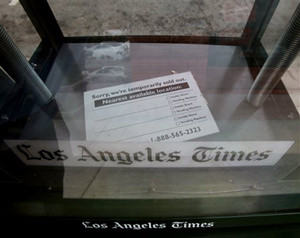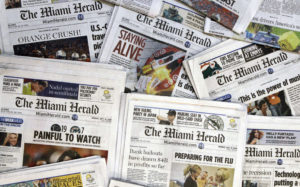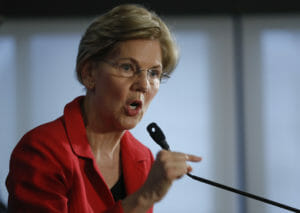Ailing Journalism in Ailing Times
The L.A. Times executive suite, desperate for company income, shows an ethics-be-damned attitude in breaching the line between ads and news.
For years, I’ve begun my mornings by reading the Los Angeles Times, and the 45 minutes I spend leafing through its pages are among the most enjoyable of my day. The ritual is a tactile and mental delight. Holding a broadsheet, having a wide spectrum of news at my fingertips, being able to take in several articles with large photos at a glance, learning which band is playing at the neighborhood gin joint as well as who has toppled whom in the latest coup … all together, it leaves me grounded and ready to face whatever the coming hours might toss at me.
On the rare mornings when the Times fails to land in my driveway, I turn to the publication’s website. For me, irrespective of how good or bad the site might be, that’s a poor substitute for an ink-on-paper daily. Peering into a computer monitor while the first cup of coffee goes to the brain is a sterile exercise compared with bending, folding, clipping, tearing and otherwise abusing a physical newspaper. Just ain’t the same thing, Bubba, and many others who grew up in pre-PC days feel the same way. Ink on paper will be in demand, at least to some extent and in some format, as long as our generation breathes and consumes.
The previous paragraph might be construed as heresy coming from the likes of me, a Truthdig editor and writer. But I don’t see it that way. I’m similar to the guy who truly loves his wife and truly loves his girlfriend too. (That image will probably cost me any wives, girlfriends and champions of holy wedlock who are reading this.) The newspaper industry is the wife who has loyally stood by me through fat and skinny days; the Internet is the exciting latecomer with flash, irresistible charm and the power of instant gratification. Weighing the pros and cons of each is a subject for another day. For now, I’ll just say that I wouldn’t want to do without either. As long as I’m able, I’ll continue to wallow in print every morning and then spend much of the rest of my waking hours neck-deep in the Internet’s pleasures and work capabilities.
Before I had the good fortune to join Truthdig, I was a happy employee of newspapers that paid me well and made me part of a lively, essential community. The last of those several publications was the Los Angeles Times, the home of many warm memories for me and still the employer of dear friends.
I’ve always considered the LAT, which has won 39 Pulitzer prizes since 1942, to be among the great dailies of modern times. In the flush years it spent lavishly and employed large staffs of some of the best writers and editors that journalism offered. In those days it was dubbed “the velvet coffin” because so many reporters and editors comfortably stayed until they retired instead of seeking out new, harder, riskier challenges in journalism. Now, the good times are gone and, some will argue, the good Times is gone.
Let me tell you about my morning of July 1. As usual, I was reading the Los Angeles Times print edition, speedily going through the paper page by page, glancing at every photograph, headline and caption and then reading those articles that engaged me.
I picked up the LATExtra section. Or at least what I thought was LATExtra, a section initiated at the Times early this year in a cost-saving move. On Jan. 8, the newspaper had announced that it was “closing its printing operations in Orange County to cut costs and will begin publishing a new section devoted to late-breaking news. … In a memo to employees, Times Publisher Eddy Hartenstein said the paper would generate ‘substantial savings’ by consolidating its printing operations at one facility in downtown Los Angeles. … To accommodate earlier deadlines necessitated by the elimination of the plant, the paper will launch a section dubbed LATExtra to run late-breaking news that was previously published in individual sections. LATExtra will appear Monday through Saturday, beginning Feb. 2. …”
The LAT has good reason to want to save money or make more money. Although it has the fourth-largest circulation in the United States — behind The Wall Street Journal, USA Today and The New York Times — it is in bankruptcy. After prospering for generations under working control of the Chandler family, the newspaper, along with related companies, was sold to the Chicago-based Tribune Co. in 2000. A parade of publishers, managing editors and other top executives followed, and in 2007 the Times fell under the hand of entrepreneur Sam Zell when he purchased Tribune.
In late 2008, Tribune filed for Chapter 11 bankruptcy. Severe staff cutbacks haven’t cured the ills of the LAT as the newspaper industry continues its swoon in the face of changing times, and neither have adjustments such as the introduction of the LATExtra section.
The 2010 changes that included the launching of LATExtra were not subtle. To my mind, however, substantial change was something the paper and its readership had to live with as much of the newspaper industry struggled for economic survival under an onslaught from the Internet and other forces. If the LAT could save money and thereby continue publishing, I was all for it. The alternative to finding new economic models and practices was probably to have no Times at all, or perhaps only a publication that looked more like a neighborhood throwaway than a major daily.
So, when July rolled in, I and other readers of the Times print edition had been seeing LATExtra for almost five months. The section heading of LATExtra — like the headings of Business, Sports, Calendar (arts and entertainment) and other sections — is cast in all-capital letters in a fairly heavy, inch-high serif type, which is topped by the words Los Angeles Times in the same typeface used for the Page 1 nameplate. With the exception of the main label, the LATExtra section heading is identical to several other section headings of the newspaper; it is unmistakable; and it is big. As I sped through the newspaper on July 1, the first thing I noticed when I came to LATExtra was that the layout of the section cover was highly unusual. The page contained two huge photos — one measuring about 14 inches deep and 8¼ inches wide, and the other about 4¼ inches deep by 8¼ inches wide. My first thought was: “Something terrible has happened … and for some reason it was not covered on Page 1.” My eye slid to the one headline on the page: “Universal Studios Hollywood Partially Destroyed; Theme park suffers massive damage, but vows to remain open.”
I was almost stunned. I wondered why I had not learned of this development from television or the Internet.
Over the years I had gone to the theme park several times, the last instance being when my wife hauled me there to see a newly released Harry Potter movie that was being screened partly in 3-D. But in that July 1 moment of surprise, what was more important than my slim personal connection to the park was that Universal, in additional to being a major player in Hollywood history, had created a renowned attraction and a business that employed many people and drew visitors who collectively spent bushels of money in the L.A. area. Also, the studio is a repository of valuable records, sets and artifacts.
In the instant when I read the headline I remembered there had been a terrible fire on the lot two years ago that destroyed historic sets and many thousands of visual and audio documents, and that the backlot had reopened only recently after restoration. Also, I recalled that a number of years earlier there had been another conflagration at the studio. (Later when I looked up the details I found that the previous fire had occurred in 1990, had caused $25 million in losses and had followed six other serious fires at Universal since 1932.)
The caption under the two big photos in the Los Angeles Times on July 1 read, in part: “Officials are at a loss to explain the seemingly random devastation.” What? Had some wingnut or terrorist tried to destroy the landmark?
The article was a litany of destruction: “… the bright façades of Universal Studio Hollywood have been darkened by the specter of actual disaster. … What was once a 23-acre neon playground and nightspot for families and tourists [CityWalk] is now strewn with charred mementos of a harrowing catastrophe. … [The] amusement park is in ruins. …”
By the time I was near the end of the 14½-inch article in my eager reading I was horrified and filled with sorrow that Los Angeles had lost one of its most famous features. Also, by that point I was puzzled by the odd phrasing in the article, and I wondered who the writer was. I had seen no byline atop the text. Then, at the end of the piece, I saw a name: Kevin Chesley. And after the name was an identification: Special Advertising Sections Writer.
A surge of anger went through me. Simultaneously I felt a stinging embarrassment that in reading hastily, I, a veteran journalist, had been taken in, duped, by a publication that was an important part of my personal and work histories. I blurted, “Son of a bitch — a sellout!” I could scarcely believe that such a deliberate deception, such an egregious breach of journalistic ethics, had been committed by a daily traditionally considered to be among the best in the United States.
I started looking for an ad label. At the upper edge of the oversized, topmost photograph — whose image suggested vaguely defined damage in front of a Universal gate — there was the telling word, in type one-eighth of an inch high: Advertisement. The 13 letters were so visually overwhelmed by the largeness of the other page elements that they did not stand out even though they were printed in red.
When I looked at the section’s Page 2 and Page 3, which bore the words Advertising Supplement in type about an eighth of an inch high, I encountered five more fake articles. Their headlines:
Colossal Footprints Found on Beach; Scientists at a loss to explain the 15-foot-long ‘possibly simian’ tracking dotting the shore from Long Beach to Santa Monica
Mysterious Gaping Hole Found in Ocean Liner; Sumatran ship smashes into a busy Southland port with its crew missing
Dodger Stadium Heavily Battered; Whole sections of the grandstands and a large swatch of the field are crushed
‘H’ from Hollywood Sign Found; The iconic letter, missing for 24 hours, is found battered and bent in the backyard of a Silver Lake resident
Planes Grounded at Southland Airports; Travel to and from international hubs suspended for the foreseeable future
The fourth and final page of the section was filled with an ad for a King Kong ride. It turns out that in this fevered advertising fantasy, the giant ape has run amok in Southern California and the “news” stories in the Los Angeles Times are detailing his fictional rampage. Well, King Kong had just made a monkey out of me.
Did someone think these fake news articles — filled with massive property damage and implications of human death — were funny? Did someone think these bogus articles would sell theme park tickets? Obviously someone did, but I’m not very interested in the ads themselves. What seizes my interest is a pair of graver questions: Has the Los Angeles Times really sunk so low? Whatever its fiscal condition and its need for income, wouldn’t shame keep it from running an advertising section gussied up to look almost exactly like the real LATExtra? (The real section was stuffed inside the fake section in the July 1 edition and, thank the heavens, contained genuine news.) The answer to the first question seems to be yes, it has sunk so low; to the second, no, shame does not constrain the current management from publishing such a section.Publisher Hartenstein stands by the special section and sees nothing wrong in what the newspaper did. Business, it seems, is business. And apparently the Los Angeles Times is now primarily about business rather than journalism, at least in the mind of Eddy Hartenstein, a former head of satellite television provider DirecTV who became the leader of the newspaper in 2008. Hartenstein, it should be noted, never has written a news article or copy-edited one on deadline, but he’s a whiz of a businessman.
I can almost hear a few readers of this article telling me to lighten the hell up and not take this advertising joke so damned seriously. My reply is, thanks but no thanks: It’s not something to be light about, and it is damned serious because the issue lies at the core of proper journalism, a pillar of American society. If it’s a joke it’s not a good one in context.
Stuff like what was in the special section is worth a laugh in articles or video clips from the satirical website The Onion (as I write this The Onion’s cover contains a “news” article headed “Restoration of ‘Star Spangled Banner’ Uncovers Horrifying New Verses”). Ditto for Andy Borowitz’s fake news that appears under that prominent label on Truthdig. But fake news doesn’t make me smile when I see it in the pages of the L.A. Times, nor would I chuckle if I saw it in The New York Times, The Wall Street Journal or The Washington Post.
Some folks higher in the social food chain than I am are similarly upset by the fabricated section. The next day, July 2, the LAT business section published a short article headlined “Supervisors protest Times ad sections; Lawmakers say promotions that resemble news pages harm credibility.” We live in strange days when a county governing board has to lecture a newspaper on journalistic ethics!
The Los Angeles County Board of Supervisors on Thursday called on the Los Angeles Times to stop selling advertising sections designed to resemble news sections, saying that the ads hurt the paper’s credibility.
The supervisors sent a letter to Sam Zell, chairman of the Tribune Co., which owns The Times. The letter came the same day the paper published a four-page ad for Universal Studios that wrapped around LATExtra, the newspaper’s breaking news section. …
… Los Angeles Times Publisher Eddy Hartenstein stood by the advertising supplement, saying such ads provide the revenues to help fund the paper’s global reporting efforts.
“The Universal Studios Hollywood ad wrapping Thursday’s LATExtra section met our advertising guidelines, including a large, red ‘advertisement’ notification on top of the page,” he said. “Our readers understand the ad-supported economic model of our business, which allows us to provide the outstanding journalism they rely upon 24/7.”
Actually, the word advertisement was not exactly “on top of the page” on the section cover; it was three inches from the top edge of the page and under three lines of type and a Benday rule. And a single word one-eighth of an inch high surely does not qualify as “large” when it is dwarfed by ginormous type and photos.
At least a few Times readers also were displeased. An LAT blog named Readers’ Representative Journal: A Conversation on Newsroom Ethics and Standards quoted some of them July 2.
… “I was frightened as I started to read about Universal Studios. When I realized it was a hoax, I was furious. How could you be so irresponsible?” said Joan Richmond of Claremont.
“Your advertisement wrap on the Thursday LATExtra section was irresponsible. Trying to make an ad, especially one that discusses devastation, look like real news is horrible,” wrote Sam Giamendi of Los Angeles.
“The clever advertising hoax played with the trust your readers have developed over the years. Please don’t toy with that trust again. What reader wants to be made to feel like a nincompoop because he or she believed what was on the front page of the L.A. Times?” asked Janet Weaver of Huntington Beach.
“Next time put the red ‘Advertisement’ notice at the top of the page in letters that can’t be missed, and do it on all the inside pages as well. What a lousy joke,” said Stan Greenfield of Woodland Hills.
(By clicking on the hyperlink atop the copy block immediately above, you can see the top parts of the fake section and the real section. The image does not contain the part showing the previously mentioned destruction near a Universal gate, or the second photo, which depicted two people facing an area littered with destroyed and smoking automobiles.)
The Wrap website observed July 1 that this is not the first time the LAT has caused a dust-up over advertising.
In March, the Times sold its front page to Disney for $700,000 to promote Tim Burton’s “Alice in Wonderland,” with Johnny Depp’s Mad Hatter covering the front page stories. …
… In April 2009, the paper stirred controversy by running an ad on its front news page for NBC’s “Southland.” At the time, critics inside the paper and out accused the Times of selling its editorial integrity for an ad, because the ad appeared at a casual glance to be an article.
Dozens of editorial staffers protested, and it ultimately led to the exit of executive editor John Arthur [in protest against the ads]. (Arthur was also critical of an ad for “The Soloist” that was published under the paper’s banner.) …
… Two months after the “Southland” incident, HBO bought a front-page wraparound ad for its “True Blood” series. …
In each case, the studios said the Times had initiated the ad packages.
The final sentence of the above quotation is remarkable: It was the L.A. Times, not the advertisers, that cooked up these journalistic atrocities. Instead of just going along with the gags, the newspaper thought them up.
In an earlier article, in 2009, The Wrap reported that LAT staffers were infuriated by the “Southland” incident:
Editorial staffers feel the ads betray and devalue their work, while the business side says they are necessary to keep the struggling paper afloat. Meanwhile, digital staffers say that their counterparts in newsprint need to wake up and face inevitable change.
“I’m just trying to keep the lights on here, folks,” pleaded publisher Eddy Hartenstein as he faced an angry newsroom … according to several people who were present. …
… Hartenstein said the paper made “six figures” in revenue for the front-page “Southland” ad.
Perhaps amid the high turnover in the LAT executive suites the Hartenstein cohort doesn’t know of, or conveniently has chosen to forget or ignore, a certain event of the dim, dark, distant past — 1999. That was the year the Times was humiliated by an ad-related scandal that generated enough controversy to merit a report on PBS’ “NewsHour With Jim Lehrer.” Mark Willes, who was the CEO of Times Mirror, then the parent company, and Times Publisher Kathryn Downing — neither of whom had any journalistic experience — were leading the newspaper when LAT executives secretly approved a deal under which the paper published a special edition of its Sunday magazine dedicated to news about Los Angeles’ new multi-sport arena, Staples Center; the plan called for covertly splitting the ad revenue profits between the newspaper and Staples. When this violation of professional ethics was exposed by other publications, the scandal reverberated throughout the journalistic world and the newspaper itself was awash in crisis. Many LAT reporters and editors were enraged by management’s betrayal, and some reportedly angrily confronted high executives, including Willes, previously the publisher, who had been ignorantly campaigning to tear down the traditional “wall” between the news/editorial staff and the advertising department.
At the time, the copy desks of the LAT were buzzing with “advice” for Downing and Willes — a former General Mills executive who after launching harsh staff cuts at the LAT became known as “the cereal killer” and “Capt’n Crunch.” Some of the advice being hashed over by us foot soldiers went like this: Mr. Willes, Ms. Downing, (1) find a college with a good basic course in journalism; (2) sign up for and attend that class; (3) learn that news is news and advertising is advertising; (3) learn that integrity, straightforwardness and a reputation for truthfulness and credibility are a newspaper’s most valuable assets — in the deepest sense, its only real assets; (4) learn that ethics matter in both business and journalism; (5) learn that not everything has a price.
Now I offer that warmed-over advice to the Times management of 2010, without change or charge. And I will toss in an extra bit: If the Los Angeles Times can stay in business only through practices that trample ethical standards and insult editorial staffers who respect and have lived by those standards, maybe the newspaper should not be in business. … What terrible words to direct at the organization I’ve revered for so long. I hope my friends at the Times will forgive me.
One person eminently qualified to speak out on the LAT is my Truthdig colleague Bill Boyarsky. Boyarsky’s list of credentials is long. He now is Truthdig’s political columnist, and last month the Los Angeles Press Club named him online journalist of the year for his work in that capacity. Boyarsky was at the Times from 1970 to 2001 in a number of roles, finally as city editor, and he is the author of a book about the Times, “Inventing L.A.: The Chandlers and Their Times.” His place in California journalism is a special one. In response to an e-mail query from me about the newest scandal at the Times, here’s what he had to say:
… When I realized it [the section about the Universal “disaster”] was another con, my reaction was disgust rather than anger. After the previous fake ad/news stories, I could see that anger is a waste of time. Ad sales now shape the Los Angeles Times, just as they do other papers, local and network television and the Internet.
This issue means a lot to me and to others from the Los Angeles Times who rebelled a decade ago against the arrangement between the paper’s magazine and Staples over the division of ad sales from a special edition of the magazine to mark the opening of Staples Center. The issue was clear. Staples would dictate or at least help shape the content. This was a clear breaking down of the wall that had separated the news and the advertising departments. Staff members signed petitions protesting the arrangement and then demanding an investigation by our media reporter, the late David Shaw, on how it happened. A climactic moment was [former Publisher] Otis Chandler’s message, which he had me deliver to the staff.
We naively thought we had won. But in the decade that followed, I have seen the so-called “wall” demolished all through the media. It seems like an archaic custom now. Mention the “wall” at one of those endless, boring conferences on the media’s future and people don’t know what you are talking about. When I see veterans of the Staples fight, we wonder what the hell we were fighting for. … The Times’ fake news stories and phony front pages are merely flagrant examples of what is happening in the media world.
When Boyarsky mentions the message from Otis Chandler he is speaking of a letter that the esteemed publisher, then retired, sent to the employees of the Times during the Staples crisis. Boyarsky told me that the Chandler communication was “the most eloquent statement I have ever seen on the need for editorial independence and freedom from advertising pressures.” Chandler, who died in 2006, wrote, in part:
My heart is heavy, my emotions are indescribable because I am afraid I am witnessing now a period in time in the history of this newspaper that is beyond description. …
If a newspaper, even a great newspaper like the Los Angeles Times, loses credibility with its community, with its readers, with its advertisers, with its shareholders, that is probably the most serious circumstance that I can possibly think of. Respect and credibility of a newspaper is irreplaceable. Sometimes it never can be restored no matter what steps might be taken in terms of apology by the publisher, apology by the head of Times Mirror or whatever post-event strategies might be developed in the hopes of putting the pieces back together.
When I think back through the history … of this great newspaper … I realize how fragile and irreplaceable public trust in a newspaper is. This public trust and faith in a newspaper by its employees, its readers, the community, is dearer to me than life itself.
Last November, Truthdig published the epilogue of Boyarsky’s book on the Times, a chapter that details the Staples imbroglio and gives a fuller version of Chandler’s message. Click here to read it.
A fitting coda for this article can be found in the Times itself, in the July 2 edition of the Readers’ Representative Journal blog. Reacting to the fake-news section promoting the King Kong ride, reader Bob Niccum wrote, “In the original ‘King Kong’ film, a promoter sought to make his fortune by bringing a monster into the city. But he didn’t foresee the damage that the monster would cause. …” I hope that registers at the Los Angeles Times. The newspaper’s deliberate failures of ethics are releasing a monster that will destroy the newspaper faster and more surely than any industrywide financial decline.
T.L. Caswell was on the Los Angeles Times editing staff for more than 25 years and now edits and writes for Truthdig.
Your support matters…Independent journalism is under threat and overshadowed by heavily funded mainstream media.
You can help level the playing field. Become a member.
Your tax-deductible contribution keeps us digging beneath the headlines to give you thought-provoking, investigative reporting and analysis that unearths what's really happening- without compromise.
Give today to support our courageous, independent journalists.




You need to be a supporter to comment.
There are currently no responses to this article.
Be the first to respond.